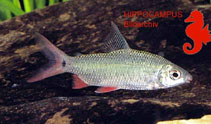| Family: |
Distichodontidae (Distichodus) |
| Max. size: |
19.5 cm TL (male/unsexed) |
| Environment: |
pelagic; freshwater; pH range: 6.5 - 7.19999980926514; dH range: 18 |
| Distribution: |
Africa: widespread in coastal basins from the Sanaga (Cameroon) to the Chiloango (Cabinda Province of Angola) (Ref. 81638). Also found in the middle (Ref. 1879, 11970) and lower Congo River basin (Ref. 88782). |
| Diagnosis: |
Dorsal spines (total): 0-0; Dorsal soft rays (total): 15-18; Anal spines: 0-0; Anal soft rays: 12-15. Diagnosis: 36 (Ref. 11970) or 38-43 (Ref. 81638) lateral line scales. Total dorsal rays 15-18; dorsal fin not becoming elongate ontogenetically, tip of fin extending at most to vertical between posterior limit of base of dorsal fin and origin of adipose fin; flanks without distinct markings other than some dusky, vertically elongate spots on mid-lateral surface; vertically elongate dark spot present on base of middle rays of caudal fin (Ref. 81638).
Description: body relatively deep, 0.33-0.42 SL, proportionally deeper in larger specimens, distinctly laterally compressed; mouth subterminal with 2 rows of bicuspid teeth in each jaw; maxilla edentulous; premaxilla with (9-)10, dentary with (9)-10 teeth in outer row; caudal fin lobes pointed, scales overlying rays; scales limited to basal portions of middle rays of each lobe in smaller individuals and extending further distally in larger specimens; body scales ctenoid and of moderate size; 5-6 scales between anal fin origin and lateral line; D: II-III,13-15; A: II-III,10-12 (Ref. 81638).
Coloration: preserved specimens yellowish to light brown, darker dorsally on head and body; head with dark pigmentation anterior to orbit and on opercle; ctenii of scales, particularly on lateral and dorsolateral portions of body, with dark chromatophores that form faint reticulate pattern; sometimes deeper-lying, dark pigmentation forming irregular, vertically elongate marks in regions along, and proximate to, lateral line in area posterior of vertical through origin of dorsal fin; such pigmentation is more obvious in smaller individuals; distinct, very elongate dark spot located over posterior-most portion of caudal peduncle and mid-basal portions of caudal fin; dorsal fin with distinct, dark mark that extends from distal two thirds of last unbranched ray to basal portions of middle and posterior rays; mark with form of posteriorly concave arch; other fins unpigmented or faintly dusky (Ref. 81638). |
| Biology: |
|
| IUCN Red List Status: |
Least Concern (LC); Date assessed: 21 July 2020 Ref. (130435)
|
| Threat to humans: |
harmless |
Source and more info: www.fishbase.org. For personal, classroom, and other internal use only. Not for publication.
